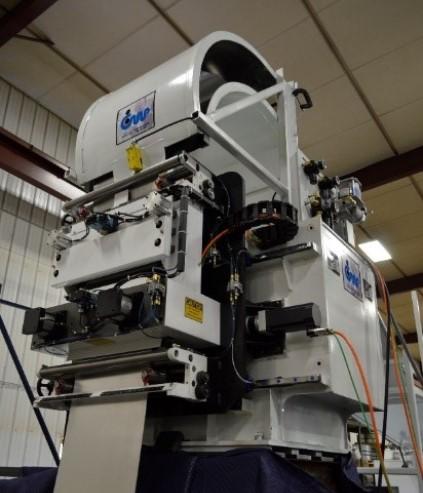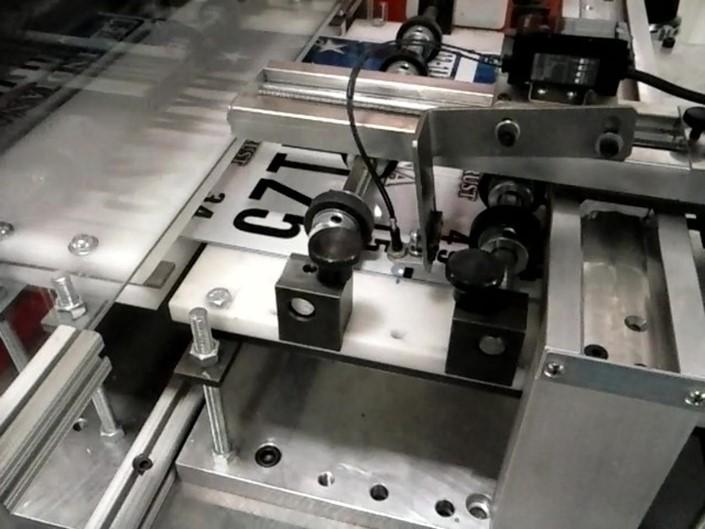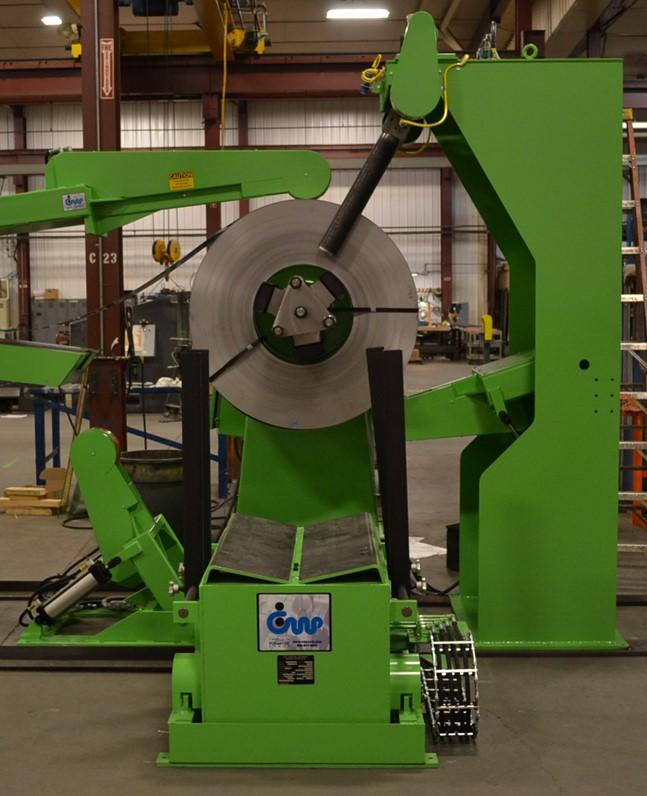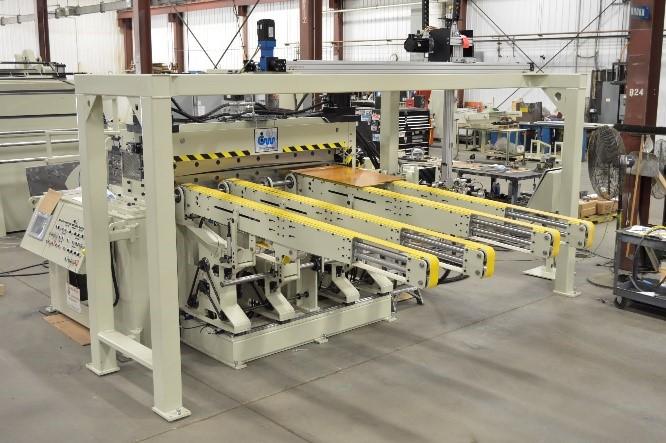vice president of sales- Midwest
- FMA
- The Fabricator
- FABTECH
- Canadian Metalworking
Categories
- Additive Manufacturing
- Aluminum Welding
- Arc Welding
- Assembly and Joining
- Automation and Robotics
- Bending and Forming
- Consumables
- Cutting and Weld Prep
- Electric Vehicles
- En Español
- Finishing
- Hydroforming
- Laser Cutting
- Laser Welding
- Machining
- Manufacturing Software
- Materials Handling
- Metals/Materials
- Oxyfuel Cutting
- Plasma Cutting
- Power Tools
- Punching and Other Holemaking
- Roll Forming
- Safety
- Sawing
- Shearing
- Shop Management
- Testing and Measuring
- Tube and Pipe Fabrication
- Tube and Pipe Production
- Waterjet Cutting
Industry Directory
Webcasts
Podcasts
FAB 40
Advertise
Subscribe
Account Login
Search
Innovations in coil metal processing, press feeding
Technology advances safety, productivity, competitiveness in stamping manufacturing
- By Kevin Enos
- February 18, 2021
- Article
- Materials Handling

A coil processing line that includes inline blanking, slitting, punching, notching, material cleaning, plastic application, shearing, and reel-to-reel coil rewinding eliminates a lot of human-powered material handling. Images provided
Technology has directly and indirectly had an impact on every part of people’s daily lives, from how they transact business and bank to how they watch TV and shop, to name a few. What has garnered fewer headlines is the impact technology has had on the manufacturing environment. Whether it is the software and hardware stampers use to design and manufacture products or tools such as servomotors, controllers, human-machine interfaces, advanced communications, and safety equipment, technology has altered stamping manufacturing in a positive way.
Not so long ago, a typical coil handling line consisted of a reel, straightener, and mechanical feeder that was crank-driven by the press. While some of these lines are still in operation today, they are as common as a phone booth or typewriter. A number of factors are driving the implementation and adoption of newer, safer automated lines that are flexible in their range and usage.
Some of them are industry-driven and some are driven by the opportunities for improving operations that technology advances have made possible:
- New stronger, tougher-to-form materials such as high-strength/low-alloy, advanced high-strength steel, and dual-phase
- Customer demand for improved part quality
- Ability to perform multiple processes inline
- Remote data collection
- Automation to speed setup, changeover times
- Reshoring of manufacturing
- Improved throughput, scrap reduction
- Remote communication with equipment for troubleshooting, maintenance
- Potential for improved worker safety
Automation Enables Reshoring
Automation has contributed to the reshoring of certain manufacturing processes because more can be accomplished with a smaller labor component, minimizing the competitive advantage of lower-cost labor in offshore companies.
For example, a coil processing line that includes inline blanking, slitting, punching, notching, material cleaning, plastic application, shearing, and reel-to-reel coil rewinding eliminates a lot of human-powered material handling (see lead image).
Integrating Blanking, Feeding, Destacking
Can you replace a conventional coil feed line with a line that can process coiled material into the press, make blanks, feed them directly into a transfer press, and, finally, destack and accurately pick and place the blanks offline—all within the existing footprint? Yes.
The coil can be processed directly into the press as it would be into a conventional line. A custom-designed system gives a stamping manufacturer the flexibility to produce the required blank lengths inline at production speed. The blanks then can be fed directly into the existing press transfer system. A magnetic conveyor system’s arms can be built and designed to adjust side to side, up and down, and in and out, independent of one another, to accommodate various material widths and lengths based on the location of the first die station. Finally, a blank destacking unit can be integrated into the system to destack and precisely place the blanks on the magnetic conveyor arms (see Figure 1).
Four-roll Feed
Another innovation is a four-roll feed, designed for nonmarking applications, cut-to-length, and heavy-gauge materials. Unlike a standard two-roll feed, the four-roll feed allows for twice the surface contact with half the amount of pressure.

Figure 3: Horizontal orientation of the press required vertical mounting of the pull-through straightener and hands-free threading.
This makes it suitable for surface-critical applications in which slippage, scratching, and marking on the material are unacceptable.
Having twice the contact surface on heavy-gauge material virtually eliminates slippage that can detrimentally affect feed length accuracy.
Zigzag Feed Calculates Optimal Movement
A zigzag servo feed provides fast, easy setup in a single- or dual-axis format (see Figure 2). The control automatically calculates the optimal movement in each axis, and the feed simultaneously or sequentially delivers the material in X-Y movement. A two- or three-out pattern is standard; up to a six-out pattern is possible.
Horizontal Orientation
Figure 3 represents an innovation dictated by a stamping manufacturer’s needs. For this application, a press that was horizontally oriented (lying on its back) required a zigzag servo feed with pull-through straightener to be vertically mounted to properly introduce the material into the press.
This project was a new concept and required development for the vertical mounting. While this line had a powered straightener, a pull-through straightener was needed to address the potential reintroduction of coil set, in which the loop reorients from the horizontal to the vertical position. A final challenge to overcome was that the entire threading process had to be hands-free because the zigzag feeder/straightener was approximately 8 ft. above floor level.
Feeding to a Registration Mark
Another development dictated by need is the ability to precisely position material via a sensor. (View video of feeding to a registration mark.)A servo/sensor feed control system is suitable for any application requiring precise accuracy of a preprinted surface. It allows accurate material positioning through precision feedback from an optical sensor. This type of control allows the operator to program a specific feed length as a basis for the move, whereby the feed moves the given distance and then "looks" for input from the sensor based on preprogrammed contrast (see Figure 4).Safety Feature Advances, Automated Communication

Figure 4: Stampers can feed to a registration mark, allowing accurate material positioning through precision feedback from an optical sensor.
Some of the most remarkable advances in coil handling and feeds are safety-geared.
More Hold-down Arms. The increasing use of higher-tensile-strength steels in more shops has elevated the need to handle the amount of stored energy inherent in the coils. The amount of memory in the high-strength coils is far greater than in mild steel, so when the bands are cut, the material tends to “clock spring.” Today many safeguards designed to protect personnel and equipment are available. These include additional hold-down arms to help contain the material and prevent the coil from clock springing when the bands are cut (see Figure 5).
The hold-down arms are also used to thread up or rewind a coil. The side guide rollers, which can be manual or motorized, are used to prevent the coil from telescoping, as well as to maintain alignment when rewinding a coil.
Safe Torque Off (STO). Another safety feature increasingly being used is STO, a function that prevents the inverter from generating torque in the motor. It ensures that no torque-generating energy continues to act on the motor and that the motor cannot be restarted until the STO is removed. What this means is that once the STO is activated, the motor will not turn after it has come to a stop.
Safe Limited Speed (SLS). This is another recent safety innovation. In practice, this is often applied as “safely reduced speed.” As a result, a defined transition from the operating speed in automatic mode to the reduced speed in setup mode must be guaranteed. If the monitoring function detects that the limit value has been violated, the drive must be shut down safely.
Perimeter and Access Guarding. Whether by hard guarding, optical, or a combination of the two, perimeter and access guarding is being used more than ever. Integrating these into a piece of equipment or into a whole line affords greater safety to the equipment and, more important, to personnel.
Automated Braking System. Using a laser to measure the coil diameter and the drive, the coil reel’s braking system is automatically adjusted throughout the depletion of the coil. This elongates the braking system’s life. It also removes this responsibility from the operator, allowing him to focus on what is coming out of the press instead of what is going in.
Bar Code Reader. Today’s integrated technologies allow for fully automated equipment that can set up a line via a bar code reader or part number. Side guides, stock guides, straightener or leveler settings, feed lengths, and so forth, are all automatically adjusted based on the bar code or job number. These automatic functions can extend to a stacking system in a cut-to-length line.
Watch video of feed to registration mark.
IIoT, External Access Communication. Good IIoT communication in a line that comprises machines made by multiple vendors is critical to safe and seamless operation. Equipment such as lubricators, cleaners, embossers, welding, transfer systems, conveyors, inspection, paper and plastic applicators, notchers, punchers, and press controls are just a few.

Figure 5: Newer coil equipment is equipped with additional hold-down arms to prevent injury from clock spring when the coil bands are cut. This one is equipped with three hold-down arms.
Stampers are increasingly using communication with external access to an internal network. The ability of the equipment manufacturer’s service personnel to perform diagnostics or program changes remotely is very important to keeping the machinery running optimally. COVID-19 has demonstrated the benefit of remote diagnostics as a safe method of troubleshooting equipment without having to enter the facility.
Servo Lift Head Case Example
A growing problem in most facilities is inadequate space availability. Typically, stampers are constrained by the existing space for their presses and ancillary equipment, pits, coil storage areas, and aisles. One stamping manufacturer faced this challenge plus one more--the cost and use of compressed air. Part of the company’s need was for a compact feed system that minimized air consumption.
The innovation was a compact feeder/straightener with a servo-driven head lift instead of the pneumatic system the company had been using. Unlike the pneumatic head that had a fixed travel distance for lifting and lowering the straightener head, the servo lift is programmable and adjustable.
Not only did the servo head lift significantly reduce the plant’s air usage, it extended equipment life because it eliminated the repetitious up- and-down movement of the pneumatic head lift. This achieved the stamper’s goals by significantly reducing the wear and tear of the machine and reducing compressed air consumption.
About the Author
Kevin Enos
76 Hinckley Road
Clinton, ME 04927
207-692-4811
Related Companies
subscribe now

The Fabricator is North America's leading magazine for the metal forming and fabricating industry. The magazine delivers the news, technical articles, and case histories that enable fabricators to do their jobs more efficiently. The Fabricator has served the industry since 1970.
start your free subscription- Stay connected from anywhere

Easily access valuable industry resources now with full access to the digital edition of The Fabricator.

Easily access valuable industry resources now with full access to the digital edition of The Welder.

Easily access valuable industry resources now with full access to the digital edition of The Tube and Pipe Journal.
- Podcasting
- Podcast:
- The Fabricator Podcast
- Published:
- 04/16/2024
- Running Time:
- 63:29
In this episode of The Fabricator Podcast, Caleb Chamberlain, co-founder and CEO of OSH Cut, discusses his company’s...
- Industry Events
16th Annual Safety Conference
- April 30 - May 1, 2024
- Elgin,
Pipe and Tube Conference
- May 21 - 22, 2024
- Omaha, NE
World-Class Roll Forming Workshop
- June 5 - 6, 2024
- Louisville, KY
Advanced Laser Application Workshop
- June 25 - 27, 2024
- Novi, MI

































